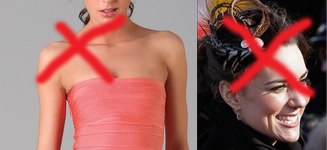Royal Ascot Dress Code Gets Tightened!
I love this move by Royal Ascot! They’ve tightened the dress code for the event!
Peoples unwillingness to stick to the traditional Royal Ascot dress code has forced the had of the racecourse to tighten the rules and clearly stipulate the yes and no’s of an outfit. This is mainly aimed at the women’s dress code.
I’ve put the dress code below but the main changes are:
- No strapless or sheer-strap tops and dresses
- Compulsory for women to wear a hat or fascinator in the public grandstand
- No fascinator, only hats in the royal enclosure
- Men must wear a suit and tie
…not to much to ask? So in image format 🙂

I’m massively in-favour of this, and I am by no means some toffee noised gent. I’m a 30 year old boy from Glasgow that has an extensive collection of baggy jeans and hoody’s to go with my ‘sharp clothing’.
Nailing down a dress code sets a standard, a bench-mark and guide which levels the playing ground and indeed make black ties more inclusive for those that don’t normally attend formal occasions. As the know exactly what to wear and will have no fear of ‘what if I’m not dressed correctly’, we’ve all been there.
No one person stands out because of their over styled clothing or colours leaving us to, dare I say it, relay on our personalities for attention.
I’m particularly in-favour of this because of personal experiences of black tie events, that when arriving turned out to be ‘fashion suits and tarty dresses’ event. I’d purchased a new dinner suit and accessories as I was assured that it was a formal black tie. When people don’t abide by the unwritten dress code it takes the shine off a night. It allows a bit of escapism from the usually increasing informal social and work environments that we all live in now.
My friend’s arrange his yearly charity black tie in Glasgow for Easter, I’m going to ask for him to take lead from Royal Ascot and tighten the dress code.
The Official Royal Enclosure Dress Code
Ladies are kindly reminded that formal day wear is a requirement in the Royal Enclosure, defined as follows:
- Dresses and skirts should be of modest length defined as falling just above the knee or longer;
- Dresses and tops should have straps of one inch or greater;
- Jackets and pashminas may be worn but dresses and tops underneath should still comply with the Royal Enclosure dress code;
- Trouser suits are welcome. They should be of full length and of matching material and colour;
- Hats should be worn; a headpiece which has a base of 4 inches (10cm) or more in diameter is acceptable as an alternative to a hat.
Ladies are kindly asked to note the following:
- Strapless, off the shoulder, halter neck, spaghetti straps and dresses with a strap of less than one inch (2.5cm) are not permitted
- Midriffs must be covered
- Fascinators are no longer permitted in the Royal Enclosure; neither are headpieces which do not have a base covering a sufficient area of the head (4 inches / 10cm)
Gentlemen
Gentlemen are kindly reminded that it is a requirement to wear either black or grey morning dress which must include:
- A waistcoat and tie (no cravats); and
- A black or grey top hat; and
- Black shoes.
A gentleman may remove his top hat within a restaurant, a private box, a private club or that facility’s terrace, balcony or garden. Hats may also be removed within any enclosed external seating area within the Royal Enclosure Garden.
The customisation of top hats (with, for example, coloured ribbons or bands) is not permitted in the Royal Enclosure.
Children
(admitted on Friday and Saturday only)
Girls (aged 10-16) should be dressed for a formal occasion. Smart summer dresses are suggested. Hats, headpieces or a fascinator may be worn but are not compulsory.
Boys (aged 10-16) should either dress in accordance with the gentlemen’s dress code (as set out above); or alternatively may wear a dark-coloured lounge suit with a shirt and tie (whereupon no hat is required).
Overseas Visitors
Overseas visitors are welcome to wear the formal National Dress of their country or Service Dress.
Serving Military Personnel
Serving military personnel are welcome to wear Service Dress or equivalent.